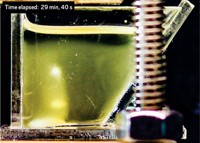Advertisement
Grab your lab coat. Let's get started
Welcome!
Welcome!
Create an account below to get 6 C&EN articles per month, receive newsletters and more - all free.
It seems this is your first time logging in online. Please enter the following information to continue.
As an ACS member you automatically get access to this site. All we need is few more details to create your reading experience.
Not you? Sign in with a different account.
Not you? Sign in with a different account.
ERROR 1
ERROR 1
ERROR 2
ERROR 2
ERROR 2
ERROR 2
ERROR 2
Password and Confirm password must match.
If you have an ACS member number, please enter it here so we can link this account to your membership. (optional)
ERROR 2
ACS values your privacy. By submitting your information, you are gaining access to C&EN and subscribing to our weekly newsletter. We use the information you provide to make your reading experience better, and we will never sell your data to third party members.
Analytical Chemistry
Tiny Device Detects Methamphetamines
Microcantilever deflection is sensitive enough to selectively detect drug molecules binding to a cavitand receptor
by Stu Borman
June 16, 2014
| A version of this story appeared in
Volume 92, Issue 24
Methamphetamines are major drugs of abuse and are difficult to detect as a class of compounds. A variety of analytical techniques including chromatography-mass spectrometry can already detect these nervous system stimulants. But existing tests often require long operation time and difficult sample preparation steps and generally detect specific compounds rather than the entire family. A group led by Paolo Bergese of the University of Brescia and Enrico Dalcanale of the University of Parma, both in Italy, has now made a start toward developing a relatively simple device that could make it possible to rapidly detect methamphetamines as a class in water (Angew. Chem. Int. Ed. 2014, DOI: 10.1002/anie.201404774). The device is based on a tetraphosphonate cavitand receptor, which binds the +NH2CH3 group present in all methamphetamine salts with high selectivity. A derivatized version of the cavitand is grafted onto the face of a silicon microcantilever. Drugs from a solution in contact with the microcantilever bind to the cavitand and cause the microcantilever to deflect. Using a laser beam to record the deflections enables the drugs to be detected. The device, which tested well with real street samples, could lead to a sensor for screening illicit drugs.





Join the conversation
Contact the reporter
Submit a Letter to the Editor for publication
Engage with us on Twitter